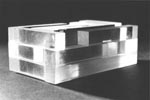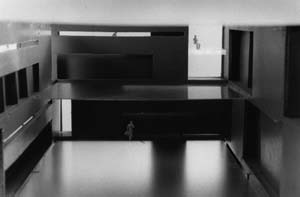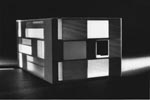|
|
BETWEEN
THE LINES:
The Electrification of the Contemporary Museum
Studio Option, Harvard GSD 1997.
Critic: Prof. Sheila Kennedy
Program
Research
|
 |
 |
 |
|
Geode |
Lightbelt |
Gallery
|

Entangelment
|

Darkbelt |

Mise-en-scene |
The Contemporary Teaching Museum rethinks the traditional museum by viewing artwork not
only as end-product exhibited at the wall (the Gallery), but also as processes of
production, study, preservation, and reproduction (the Atelier, the Conservation, and the
Study Collection).
The challenge of this
architectural problem lies in connecting and entangling the passive, public, hybrid
Gallery with the active, private, light working areas by keeping their specific
characterizations and qualities. A structural concrete Darkbelt of sensing,
storage, and service space acts as the link and the seam in-between the Lightbelt
of offices and work space facing the exterior and the multi-function gallery enclosed in
the interior:
The Darkbelt is not a line or a
wall, it is a programmed space that is inhabited.
|
|
The Darkbelt …
contains all shared infrastructures
(service zones, moveable furniture, bookshelves, computer workstations);
provides artificial light, air, water, heat, and electricity;
stores and exhibits artifacts, information, tools and
heat from the sun;
structures and even carries the Gallery and the Lightbelt;
regulates the circulation flow;
attracts the attention of the viewer through
illuminated niches and openings (sensing spaces)
affords privacy for studying and viewing artwork while having a visual
connection to the whole;
lets the inside out and outside in through openings, breakthroughs,
punctures, ruptures, displacements, gaps, voids, apertures,…
Through the medium of the Darkbelt the museum
opens itself up to the outside breaking the sacrality and closeness of the white cube.
|
|